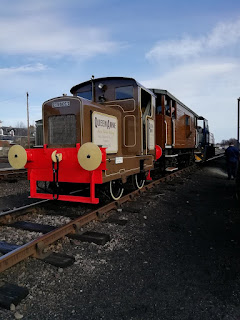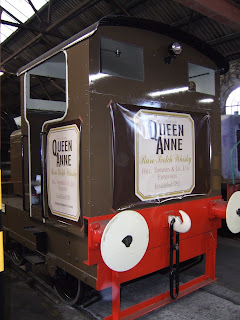The Earliest Distillery Shunters
While many distilleries had sidings connected to the main line, few had their own shunters. One source quotes the Ardgowan distillery on the south bank of the Clyde near Greenock as having its own Barclay 0-4-0ST built in 1894. Several Speyside distilleries bought their own shunting locomotives in the late 1890s – Glenlossie (part of the private rail network at Longmorn) in 1896, Daluaine 1897 and Balmenach 1897. Longmorn Distillery’s first locomotive was a McLaren 2-2-0 “traction engine” locomotive of 1898.
The reason for mentioning these early locomotives is that we are now in possession of two lamps that were originally fitted to Longmorn’s McLaren 2-2-0 of 1898. A man (name unknown) who had previous associations with Longmorn distillery came to the locoshed to donate the lamps in his possession. It is believed that he was given a footplate ride on Queen Anne at the 2022 Strathspey Diesel Gala – thank you very much for your generous donation. The McLaren was in use until 1948 when Queen Anne was bought to replace it.
The lamps are of a style fitted to traction engines as they have one forward facing lens and a second window on one side. They are a right and left-handed pair that were carried on either side of the smokebox. There is a photograph on the Railscot website that shows the discarded McLaren locomotive at Longmorn around 1951 and you can see a lamp bracket on the side of the smokebox.

Note lamp bracket on the smokebox
Click here to view the full image on the Railscot website.
The lamps are made of tinplate by Eli Griffiths of Birmingham. They had been painted latterly in bronze metallic paint and were in moderate condition. After blasting away the paint, one lamp was in very good condition with only minor corrosion, although the tin plating had largely gone. The other had more corrosion and will need repairs with tinplate. The removable paraffin burners inside were also in need of repair. Their butt-soldered joints had obviously caused problems with leakage in the past and the wick holders were missing.
 |
| The lamps as donated |
 |
| Maker's plate on oil burner |
It was decided to restore the lamps retaining as much as possible of the original material and dents etc. After cleaning, the better lamp was painted with 2-part epoxy primer to prevent further corrosion and then sprayed gloss black. The other lamp will need repairs before getting similar treatment. The burners were repaired with tinplate. Strips of folded tinplate were soldered over the edges where paraffin leakage had been a problem. A spare wick holder from a different lamp was found and adapted to fit one of the lamps. A second identical brass filler/vent was turned up to replace one that was missing.
 |
| Restored Lamp |
 |
| Restored oil burners |
The Strathspey Railway doesn’t really have any safe storage for historic items so the lamps will remain with Queen Anne for now. One possibility is to bolt on temporary lamp brackets on either side of the locomotive at the front. Queen Anne is already the guardian of one historic item – a Highland Green watering can with the legend “HR REDCASTLE” painted on the side. Redcastle was a station on the old Black Isle line to Fortrose. A long time ago this item had been in the collection of a small museum at Boat of Garten, but it was found in the skip. After repairing the spout, it is now used to top up Queen Anne’s radiator.
Chain Oilers
The oiling system is still not complete. The brush oilers have been obtained and these need to be fitted in place and connected to the oil pots. Brackets have been made and piping obtained.
The oil pots and their solenoid valves have been fitted and wired in so that they dispanse oil when the engine is running.
 |
| One of the oil pots with solenoid valve |
Control Box Improvement
The four electrical push/pull switches on the control box were fixed in with mild steel fittings. However these had become corroded in the damp atmosphere of the locoshed. It was decided to make new fittings out of stainless steel and these have now replaced the old mild steel ones.
 |
| The old mild steel fittings |
 |
| Control box with stainless fittings |
Gearbox Oil Valve
The Ruston 48DS gearbox has a slightly odd lubrication system. There is a valve that is accessible through a hole in the cab floor and operated by a special key. The valve should be closed while running but turned to the open position when the locomotive is not in use. A sign in the form of a brass disc was created using the CNC router at Kingussie High School to do the engraving. The sign reminds the driver to turn the valve clockwise (close) while running and anticlockwise (open) when stopped. Three Terry Clips were screwed to the bulkhead in the cab to hold the special key to operate the valve.
 |
| The engraved sign |
 |
| Special operating key |
Hopefully this will remind drivers of the correct procedure to follow.
Memorabilia
The “ignition key” for Queen Anne is kept in a key safe in the office at Aviemore along with other diesel loco keys etc. On a whim, the term “queen anne keyring” was searched online and a Queen Anne whisky keyring came up on Ebay. The price was £1.63 with carriage £1.90 + import VAT as it was located in the Netherlands. So the key is now instantly recognisable inside the key safe.
 |
| Key Ring |
 |
| Other Memorabilia |
Gearbox
It was noticed around the time of the 2022 Diesel Gala that when using 1st gear to pull away with a load, the corresponding clutch would slip unless the clutch spring was tightened very much more than it should be. 2nd and 3rd gear worked without problems and provided the load is not too heavy, the loco will happily pull away in 2nd gear.
The Ruston design of gearbox fitted to Queen Anne and many narrow-gauge shunters was very successful and is a constant-mesh type that uses separate clutches to engage each gear. The problem with 1st gear is most likely due to the corresponding friction pads being worn down to the rivets.
Dismantling the gearbox is quite straightforward, and fortunately we have the 48DS manual that gives full details of dismantling and servicing. After removing the cab floor the upper gearbox casing is removed and lifted away. It weighs 3 cwt (150 kg) so will probably require some sort of hoist. After that the main gear assembly can simply be lifted out and taken to the bench for servicing.
The 1st and 2nd gear clutches are removed together. The 3rd gear clutch which gives straight-through drive without reduction takes longer to remove. The friction pad thickness can be observed without dismantling and the 3rd gear pads may not be renewed if they have sufficient thickness left. There are a number of companies that replace clutch and brake friction pads on historic vehicles and it is hoped they will be able to refurbish the friction plates at reasonable cost.
The plan is to do this job over the winter.



























